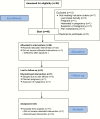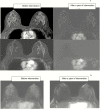3,3-Diindolylmethane (DIM): a nutritional intervention and its impact on breast density in healthy BRCA carriers. A prospective clinical trial
- PMID: 32458980
- PMCID: PMC7566319
- DOI: 10.1093/carcin/bgaa050
3,3-Diindolylmethane (DIM): a nutritional intervention and its impact on breast density in healthy BRCA carriers. A prospective clinical trial
Abstract
Women who carry the BRCA mutation are at high lifetime risk of breast cancer, but there is no consensus regarding an effective and safe chemoprevention strategy. A large body of evidence suggests that 3,3-diindolylmethane (DIM), a dimer of indole-3-carbinol found in cruciferous vegetables, can potentially prevent carcinogenesis and tumor development. The primary aim of this prospective single-arm study was to investigate the effect of DIM supplementation on breast density, a recognized predictive factor of breast cancer risk. Participants were 23 healthy female BRCA carriers (median age 47 years; 78% postmenopausal) who were treated with oral DIM 100 mg × 1/day for 1 year. The amount of fibroglandular tissue (FGT) and background parenchymal enhancement (BPE) on magnetic resonance imaging (MRI) performed before and after the intervention was scored by two independent expert radiologists using the Breast Imaging and Reporting Data System. The results showed a decrease in the average score for FGT amount from 2.8 ± 0.8 at the onset to 2.65 ± 0.84 after 1 year (P = 0.031), with no significant change in BPE (P = 0.429). A group of DIM-untreated age- and menopausal-status-matched women from the BRCA clinic did not show a significant change in FGT amount (P = 0.33) or BPE (P = 0.814) in a parallel year. Mean estradiol level decreased from 159 to 102 pmol/l (P = 0.01), and mean testosterone level decreased from 0.42 to 0.31 pmol/l (P = 0.007). Side effects were grade 1. In conclusion, 1 year's supplementation with DIM 100 mg × 1/day in BRCA carriers was associated with a significant decline in FGT amount on MRI. Larger randomized studies are warranted to corroborate these findings.
© The Author(s) 2020. Published by Oxford University Press.
Figures


Similar articles
-
Assessment of Background Parenchymal Enhancement and Lesion Kinetics in Breast MRI of BRCA 1/2 Mutation Carriers Compared to Matched Controls Using Quantitative Kinetic Analysis.Acad Radiol. 2016 Mar;23(3):358-67. doi: 10.1016/j.acra.2015.11.011. Epub 2016 Jan 7. Acad Radiol. 2016. PMID: 26774741 Free PMC article.
-
BRCA1 mRNA levels following a 4-6-week intervention with oral 3,3'-diindolylmethane.Br J Cancer. 2014 Sep 23;111(7):1269-74. doi: 10.1038/bjc.2014.391. Epub 2014 Jul 15. Br J Cancer. 2014. PMID: 25025957 Free PMC article. Clinical Trial.
-
Quantitative assessment of background parenchymal enhancement is associated with lifetime breast cancer risk in screening MRI.Eur Radiol. 2024 Oct;34(10):6358-6368. doi: 10.1007/s00330-024-10758-9. Epub 2024 Apr 29. Eur Radiol. 2024. PMID: 38683385 Free PMC article.
-
Chemopreventive properties of 3,3'-diindolylmethane in breast cancer: evidence from experimental and human studies.Nutr Rev. 2016 Jul;74(7):432-43. doi: 10.1093/nutrit/nuw010. Epub 2016 May 31. Nutr Rev. 2016. PMID: 27261275 Free PMC article. Review.
-
Chemoprevention of breast cancer.Surg Clin North Am. 1999 Oct;79(5):1207-21. doi: 10.1016/s0039-6109(05)70069-4. Surg Clin North Am. 1999. PMID: 10572559 Review.
Cited by
-
Exploring the impact of 3,3'-diindolylmethane on the urinary estrogen profile of premenopausal women.BMC Complement Med Ther. 2024 Nov 22;24(1):405. doi: 10.1186/s12906-024-04708-7. BMC Complement Med Ther. 2024. PMID: 39578798 Free PMC article.
-
Aryl hydrocarbon receptor: An emerging player in breast cancer pathogenesis and its potential as a drug target (Review).Mol Med Rep. 2024 Jan;29(1):11. doi: 10.3892/mmr.2023.13134. Epub 2023 Nov 24. Mol Med Rep. 2024. PMID: 37997818 Free PMC article. Review.
-
The impact of 3,3'-diindolylmethane on estradiol and estrogen metabolism in postmenopausal women using a transdermal estradiol patch.Menopause. 2025 Jul 1;32(7):630-639. doi: 10.1097/GME.0000000000002542. Menopause. 2025. PMID: 40298801 Free PMC article.
-
The Role of the Aryl Hydrocarbon Receptor (AhR) and Its Ligands in Breast Cancer.Cancers (Basel). 2022 Nov 14;14(22):5574. doi: 10.3390/cancers14225574. Cancers (Basel). 2022. PMID: 36428667 Free PMC article. Review.
-
The Role of Natural Products and Their Multitargeted Approach to Treat Solid Cancer.Cells. 2022 Jul 15;11(14):2209. doi: 10.3390/cells11142209. Cells. 2022. PMID: 35883653 Free PMC article. Review.
References
-
- NCCN. Clinical Practice Guidelines in Oncology, Version 3 http://www.nccn.org/professionals/physiciangls/pdf/genetics_screening.pdf (15 November, 2015, date last accessed).
-
- Rogan E.G. (2006) The natural chemopreventive compound indole-3-carbinol: state of the science. In Vivo, 20, 221–228. - PubMed
-
- Graham S. et al. (1982) Diet in the epidemiology of breast cancer. Am. J. Epidemiol., 116, 68–75. - PubMed
Publication types
MeSH terms
Substances
LinkOut - more resources
Full Text Sources
Medical

